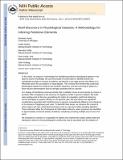Motif Discovery in Physiological Datasets: A Methodology for Inferring Predictive Elements
Author(s)
Syed, Zeeshan; Stultz, Collin M.; Kellis, Manolis; Indyk, Piotr; Guttag, John V.
DownloadGuttag_Motif Discovery.pdf (3.992Mb)
OPEN_ACCESS_POLICY
Open Access Policy
Creative Commons Attribution-Noncommercial-Share Alike
Terms of use
Metadata
Show full item recordAbstract
In this article, we propose a methodology for identifying predictive physiological patterns in the absence of prior knowledge. We use the principle of conservation to identify activity that consistently precedes an outcome in patients, and describe a two-stage process that allows us to efficiently search for such patterns in large datasets. This involves first transforming continuous physiological signals from patients into symbolic sequences, and then searching for patterns in these reduced representations that are strongly associated with an outcome.
Our strategy of identifying conserved activity that is unlikely to have occurred purely by chance in symbolic data is analogous to the discovery of regulatory motifs in genomic datasets. We build upon existing work in this area, generalizing the notion of a regulatory motif and enhancing current techniques to operate robustly on non-genomic data. We also address two significant considerations associated with motif discovery in general: computational efficiency and robustness in the presence of degeneracy and noise. To deal with these issues, we introduce the concept of active regions and new subset-based techniques such as a two-layer Gibbs sampling algorithm. These extensions allow for a framework for information inference, where precursors are identified as approximately conserved activity of arbitrary complexity preceding multiple occurrences of an event.
We evaluated our solution on a population of patients who experienced sudden cardiac death and attempted to discover electrocardiographic activity that may be associated with the endpoint of death. To assess the predictive patterns discovered, we compared likelihood scores for motifs in the sudden death population against control populations of normal individuals and those with non-fatal supraventricular arrhythmias. Our results suggest that predictive motif discovery may be able to identify clinically relevant information even in the absence of significant prior knowledge.
Date issued
2010-01Department
Massachusetts Institute of Technology. Department of Electrical Engineering and Computer ScienceJournal
ACM Transactions on Knowledge Discovery from Data (TKDD)
Publisher
Association for Computing Machinery (ACM)
Citation
Zeeshan Syed, Collin Stultz, Manolis Kellis, Piotr Indyk, and John Guttag. 2010. Motif discovery in physiological datasets: A methodology for inferring predictive elements. ACM Trans. Knowl. Discov. Data 4, 1, Article 2 (January 2010), 23 pages.
Version: Author's final manuscript
ISSN
1556-4681
1556-472X